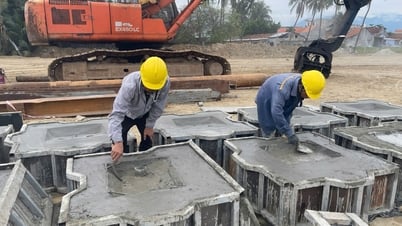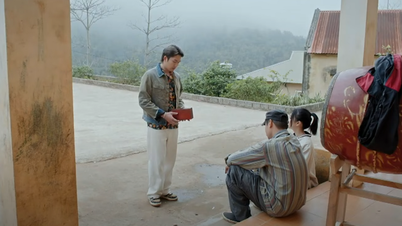The older the ginger, the spicier it is.
The clip, filmed from inside one of the Crotale-NG battery’s control vehicles, shows the system’s optical sensor locked onto a Russian cruise missile hurtling toward a target in Ukraine. The first shot at the missile appears to miss, but the second, which can be clearly seen on the screen, passes over the target and explodes violently, causing the crew to cheer loudly.

A Crotale-NG air defense missile system similar to the one France provided to Ukraine - Photo: HuffPost
French Defense Minister Sébastien Lecornu first confirmed the delivery of two Crotale-NG batteries in November 2022. President Emmanuel Macron later mentioned the aid in a speech aboard the French aircraft carrier Charles de Gaulle in December.
Crotale is a short-range air defense system designed during the Cold War to defend a defense zone against medium- and low-altitude aircraft – the same range at which Russian cruise missiles are often launched at Ukraine.
Although unable to reach aircraft at high altitudes, Crotale-NG batteries still pose a major threat to helicopters, drones at low to medium altitudes, and fighter aircraft in case they dive to drop bombs or fire ground-attack missiles.
The Crotale-NG batteries (nicknamed “rattlesnakes”) that Paris is providing to Kiev consist of two components: 4.3-ton trailers with rotating turrets loaded with eight VT1 missiles each, and a fire control vehicle that can be connected to two to four launchers.
The fire control vehicle provides the ability to detect up to 12 threats simultaneously at a range of 20 km using the Mirador IV S-band doppler radar. It can also classify targets using the Identification Friend or Foe (IFF) function to instruct the launcher.
The launchers then lock onto the target using a turret-mounted fire control radar; this radar can track a specific target at a range of up to 30 km. The turret also uses both day and night optical sensors and an infrared rangefinder that can visually track targets at a range of 15-20 km.
Thanks to the high level of automation, the process of detecting, identifying and making combat decisions for the “rattlesnake” takes only 5 seconds. When receiving the command to fire, the launchers can launch up to 2 VT-1 missiles consecutively for each target. A salvo of 2 missiles of Crotale-NG is estimated to achieve a 90% probability of destroying the targets.
VT1 missiles reach speeds of up to 3.5 times the speed of sound and are guided via narrow-beam radio commands based on a combination of radar and optical sensors. The use of multiple sensors makes the guidance system more accurate, harder to counter, and able to operate in all weather conditions.
The missile is designed to fly above its target before launching a 13.5kg fragmentation warhead that will tear apart everything behind it in a deadly 8m arc.
The classic, analog Star Trek-style interface — with its CRT display and flashing colored lights — is undeniable evidence that the Crotale-NG dates from the late 1980s. It's a fairly old missile compared to advanced short-range air defense systems like NASAMS and IRIS-T, which were also provided by the West to Ukraine.
But in reality, Crotale-NG is still very effective, as it has been shown on the battlefield for decades. In the last two decades of the Cold War, Crotale-NG systems were deployed in the Iran-Iraq war, launched at Libyan Tu-22s over Chad, fired by Libya at US F-111s in 1986, and deployed in the 1991 Gulf War.
Now in its “middle age”, the Crotale-NG is still fighting very well, as evidenced by the excellent cruise missile interception that Ukraine recently shared. It is known that the Crotale-NG systems Kiev received from Paris are a second-generation design, with many modifications and introduced in 1989.
When both sides throw everything into the fight…
Ukrainian President Volodymyr Zelenskyy has publicly stated that he still hopes to receive from France or Italy the SAMP/T medium-to-long-range air defense system equipped with Aster missiles. With the ability to destroy targets at altitudes of 15-30 km (depending on the Aster 15 or Aster 30 variant), this is the Western European missile closest to the US Patriot system.

Crotale-NG's VT1 missile just came out of the launch tube, this type of missile reaches Mach 3.5 speed and has a fragmentation warhead - Photo: Army Technology
But it would be a mistake to scoff at the transfer of older SAMs like the Crotale or the US MIM-23 HAWK to Ukraine, because Russia’s intense and dense long-range missile attacks amount to a war of attrition against Ukraine’s air defenses.
Russia has used nearly all of its cruise missile arsenal in the war. It has had to use both Bastion anti-ship missiles and S-300 air defense missiles for ground attack purposes, as well as removing nuclear warheads from some of its cruise missiles so they can attack Ukraine with conventional warheads.
Meanwhile, many of Ukraine's Soviet-era air defense missiles — especially long- and medium-range systems like the S-300 and Buk — are largely unusable due to their reliance on components made only in Russia, including klystron vacuum tubes.
So being able to intercept more missiles, regardless of cost/value and range, is important for Ukraine. Kiev cannot afford to run out of air defenses, and by making good use of older “toys” like the Crotale-NG, it can reserve the best weapons to deal with manned fighters, advanced high-altitude drones or ballistic missiles.
The Rattlesnake would also be an effective and inexpensive weapon to intercept subsonic cruise missiles or cheap kamikaze drones that Russia has purchased from Iran. The Crotale-NG aid is therefore a “win-win” option for a missile system that France plans to retire in the next decade.
Quang Anh
Source


![[Photo] Scientific workshop "Building a socialist model associated with socialist people in Hai Phong city in the period of 2025-2030 and the following years"](https://vphoto.vietnam.vn/thumb/1200x675/vietnam/resource/IMAGE/2025/5/21/5098e06c813243b1bf5670f9dc20ad0a)
![[Photo] Determining the pairs in the team semi-finals of the National Table Tennis Championship of Nhan Dan Newspaper](https://vphoto.vietnam.vn/thumb/1200x675/vietnam/resource/IMAGE/2025/5/21/eacbf7ae6a59497e9ae5da8e63d227bf)

![[Photo] Prime Minister Pham Minh Chinh receives Rabbi Yoav Ben Tzur, Israeli Minister of Labor](https://vphoto.vietnam.vn/thumb/1200x675/vietnam/resource/IMAGE/2025/5/21/511bf6664512413ca5a275cbf3fb2f65)
![[Photo] Prime Minister Pham Minh Chinh attends the groundbreaking ceremony of Trump International Hung Yen Project](https://vphoto.vietnam.vn/thumb/1200x675/vietnam/resource/IMAGE/2025/5/21/ca84b87a74da4cddb2992a86966284cf)




























































































Comment (0)